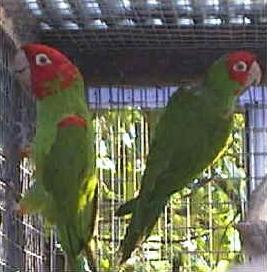Conure - Red Fronted
Scientific Name: Aratinga wagleri
Tue, 15th July, 2025 - 9:54 pm GMT
Sponsor Ads:

Alternative Name
Scientific Name: Aratinga wagleriBasic Info
At maturity, Red-fronted Conures average between 14 and 15 inches in length. They are the second largest Conure! Their plumage is predominantly green, with breast feathers being colored lighter green than the body feathers. The bend of the wing is red, as is the face above the ceres, in addition to the forehead and crown. Occasionally, Red-fronted Conures have a sprinkling of red feathers or a full red band across their throats. The undersides of a Red-fronted Conure's flight feathers, under-wing coverts and tail feathers are olive-yellow. The periopthalmic ring is white as is typical of Conures, and the iris is yellow-red. Red-fronted Conures have horn-colored bills and brownish legs.
Health
Red-fronted Conures should be fed a basic seed mix or pellet food, supplemented with a variety of fruits and vegetables. They need fresh water available to them at all times and a nesting box to hide in when they feel stressed. Red-fronted Conures also need a variety of toys and chew items to keep them from becoming bored when you are not around to play with your sweet little friend. As with all birds, captive-bred and hand-raised Red-fronted Conures make much better pets than wild-caught birds. They are healthier, tamer and generally more affectionate. Breeding In order to sex your Red-fronted Conure, you will need a surgical or DNA test. Not much is known about the breeding habits of these lovely birds. When young, they are frequently mistaken even by experts for Mitred Conures! Young Red-fronted Conures lack red fronts and heads- their plumage is green.Habitat
The Red-fronted Conure prefers untouched, virgin forest, and is the most common parrot in the Venezuelan cloud forests!Behavior
If you are looking for a Conure who is a good talker and is beautifully colored, you might want to meet a Red-fronted Conure! Red-fronted Conures are native to rain forests, where they fly from their roosting site to their feeding site and back each day. They nest in holes in rocks in the foothills or on mountain slopes! Red-fronted Conures are social animals in the wild, and flocks of up to 300 birds have been seen! In captivity, they need constant amusement and companionship to keep them from becoming bored. Although they are a quieter Conure, they may be loud and do have the typical Conure shriek! Generally, Red-fronted Conures will only shriek if they feel threatened in some way. Red-fronted Conures are excellent talkers and can learn a few simple words and phrases. Red-fronted Conures also have very complicated speech patterns in their own prolific language! They are easy to train and make good companions! They can cost up $400.00, when you can find one. They need fresh water available to them at all times and a nesting box to hide in when they feel stressed. Red-fronted Conures also need a variety of toys and chew items to keep them from becoming bored when you are not around to play with your sweet little friend.Origin
VenezuelaHistory
There are four subspecies of Red-fronted Conure, all native to the humid forest regions of Columbia, northern Venezuela, southern Peru and western Ecuador. Red-fronted Conures have become popular as pets and in the wild, they continue to flourish in very remote or protected forest regions. They were first officially recognized by G.R. Gray in 1845.Common Foods
In the wild, Red-fronted Conures eat seeds, fruits, nuts and berries, which they procure in their preferred tree-top habitat. In captivity, Red-fronted Conures should be fed a basic seed mix or pellet food, supplemented with a variety of fruits and vegetSponsor Ads:
It is better to resign from office than it is to die in office; that way, you get to hear some of the eulogies. -- Unknown
Conure - Red Fronted
Coded by: BGID® | ALL RIGHTS RESERVED Copyright © 2000-2025
Disclaimer | Privacy | Report Errors / Contact | Credits








 Preparing For China. China is growing their military. China Military Technology - can it keep up with the US?
Preparing For China. China is growing their military. China Military Technology - can it keep up with the US?  versus
versus 

 versus
versus 
 This Thread is about the North Korean Military itself - the kind of army, navy, and air force they have.
This Thread is about the North Korean Military itself - the kind of army, navy, and air force they have. 
 versus
versus 
 versus
versus  versus
versus